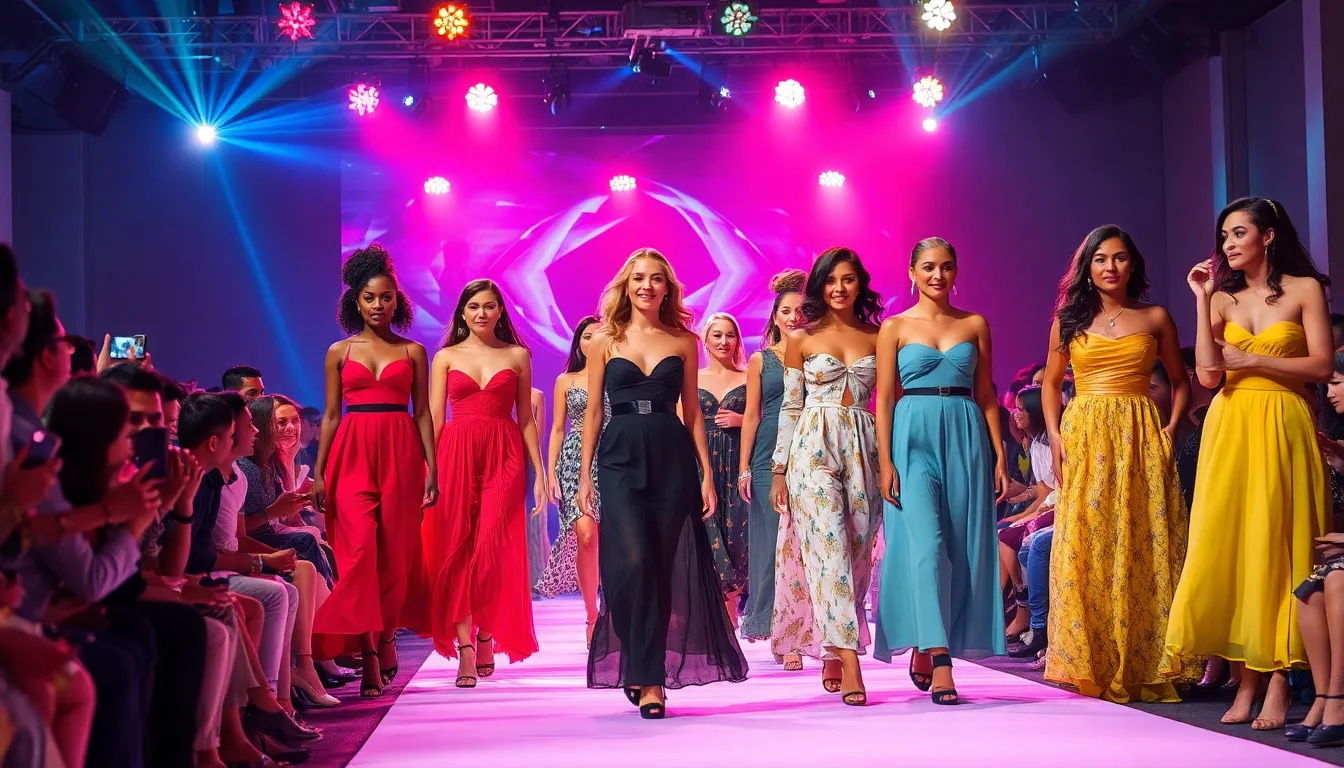Table of Contents
ToggleIn the fast-paced world of fashion, standing out is no longer just a goal—it’s a necessity. Creative fashion presentations are the secret sauce that transforms ordinary runway shows into unforgettable experiences. Imagine models strutting down the catwalk not just in clothes, but in stories that captivate and inspire. It’s not just about fabric; it’s about flair.
Gone are the days of simple presentations. Today, designers are pushing boundaries, using innovative concepts and technology to showcase their collections. From interactive displays to immersive environments, the fashion world is a playground for creativity. So, grab your front-row seat and get ready to explore how these bold presentations can elevate a brand’s identity and leave audiences wanting more. After all, who wouldn’t want a little extra pizzazz with their Prada?
Overview of Creative Fashion Presentation
Creative fashion presentations transform traditional runway shows into engaging experiences. Designers utilize innovative concepts to captivate audiences and highlight their collections. Technology plays a significant role in these presentations, enhancing visual storytelling. Interactive elements, such as augmented reality or digital backdrops, immerse viewers in the designer’s vision.
Artistic direction in fashion showcases often embraces theatricality, creating a narrative that resonates with the audience. Unique settings and unexpected venues amplify the impact of the collection. From art galleries to outdoor locations, diverse environments add an exhilarating twist.
Lighting and sound design also contribute to the overall atmosphere of the presentation. Sophisticated lighting can shift focus and create mood, while curated music aligns with the brand identity. This integrative approach brings collections to life and fosters emotional connections.
Fashion films have gained popularity as an alternative to live presentations. These short films allow designers to experiment with storytelling beyond the runway. Through cinematography and narrative structure, designers communicate their message effectively.
A successful creative fashion presentation reflects careful planning and cohesive branding. Attention to detail, from models’ styling to accessories, reinforces the designer’s aesthetic. This comprehensive approach ensures that every element harmonizes with the core vision.
Overall, creative fashion presentations challenge the conventions of the industry. They invite audiences to engage more deeply with fashion while offering memorable experiences that resonate beyond the show.
Importance of Creative Fashion Presentation

Creative fashion presentations play a crucial role in shaping brand perception and engaging audiences. They elevate the experience of a runway show, transforming it into an artistic showcase rather than a mere display of clothing.
Engaging the Audience
Engagement occurs through storytelling and immersive experiences. Designers leverage innovative concepts to captivate viewers. Interactive elements like augmented reality enhance connection. Unique settings invite audiences to explore collections in dynamic ways. The combination of visuals, music, and performance creates a memorable atmosphere. Participants often find themselves part of the narrative, fostering emotional ties to the brand. Such involvement encourages social sharing, amplifying reach and visibility.
Enhancing Brand Image
A strong brand identity emerges from creative presentations. Distinctive shows set brands apart in a saturated market. They communicate values and aesthetics through visuals and experiences. Effective use of lighting and sound aligns with brand messaging, reinforcing recognition. Film-based presentations offer a storytelling avenue that deepens connections with consumers. Unique experiences leave lasting impressions, transforming first-time viewers into loyal customers. Creativity contributes to a perception of innovation, enhancing overall brand appeal.
Techniques in Creative Fashion Presentation
Creative fashion presentations utilize various techniques to engage audiences and create lasting impressions. These methods have evolved to incorporate visual storytelling and innovative technology.
Visual Storytelling
Visual storytelling plays a crucial role in captivating viewers. Designers convey narratives through carefully curated visual elements, making collections resonate emotionally. They use color palettes, textures, and themes to evoke specific feelings and ideas. Each outfit tells part of a broader story, enhancing audience connection. Events often integrate striking imagery and symbolic motifs, offering deeper insights into the brand identity. This strategic approach transforms runway shows into immersive experiences, allowing attendees to feel part of the narrative.
Innovative Use of Technology
Innovative use of technology elevates fashion presentations to new heights. Augmented reality and virtual reality create interactive experiences, allowing audiences to engage with collections from their own devices. Incorporating projections and digital displays amplifies the overall visualization, engaging viewers in unique ways. Some brands even experiment with 3D printing, unveiling designs in real-time during shows. By merging fashion with technology, designers create memorable, shareable moments. This synergy not only enhances presentation but also fosters brand loyalty and opens up new avenues for marketing and outreach.
Famous Examples of Creative Fashion Presentations
Creative fashion presentations have captured the attention of audiences worldwide through iconic shows and unique marketing campaigns.
Iconic Fashion Shows
Notable fashion shows displayed creativity in exceptional ways. Alexander McQueen’s “Plato’s Atlantis” showcased models walking on a transparent runway while digital projections enhanced the experience. Chanel transformed its venue into a supermarket for its Spring/Summer 2014 show, merging high fashion with everyday consumerism. Balenciaga presented its Fall/Winter 2021 collection in a dystopian setting with models donning face masks and oversized garments, reflecting the contemporary climate. Each experience transcended conventional presentations, blurring the lines between art and fashion, and establishing these shows as milestones in innovative storytelling.
Unique Marketing Campaigns
Unique marketing campaigns often redefined the parameters of fashion advertising. Burberry utilized live streaming to bring its audience into the show, allowing viewers to purchase items directly after the runway. The Maison Margiela “Artisanal” presentation featuring upcycled materials resonated with sustainability-focused consumers while emphasizing artistry. Gucci’s “Eternity” digital campaign blended fashion photography with vibrant visuals, turning social media into a gallery of its own. These campaigns harnessed creativity, resulting in deeper connections with audiences and enhanced brand visibility, effectively positioning each brand within the competitive landscape.
Trends in Creative Fashion Presentation
Innovative storytelling stands out as a key trend in creative fashion presentations. Designers leverage visual narratives to express brand identity through color palettes and textures. Experiencing fashion becomes immersive for viewers, as emotions are evoked by curated visual elements.
Technology also plays a crucial role in shaping presentations. Augmented reality and virtual reality transform traditional formats into interactive experiences, allowing audiences to engage actively. Incorporating 3D printing unveils designs in real-time, further enhancing the spectacle.
Unique settings create unforgettable atmospheres. Fashion showcases take place in unconventional locations, offering fresh perspectives to audiences. Iconic examples include Alexander McQueen’s “Plato’s Atlantis” show with its theatrical sea motifs and Chanel’s supermarket-themed Spring/Summer 2014 collection.
Sound design complements visual experiences effectively, creating a multisensory environment. Each presentation utilizes music and soundscapes that resonate with brand identity, deepening audience connection. Brands like Balenciaga thoughtfully curate audio to align with their aesthetic, enhancing overall impact.
Social media engagement has become essential. Fashion presentations encourage sharing through interactive elements, expanding reach beyond the physical venue. Audiences connect with the narrative on platforms, becoming brand advocates.
Sustainability continues to shape presentations. Designers incorporate eco-friendly materials and themes into their shows, responding to consumer demands for responsible fashion. Initiatives like Maison Margiela’s sustainability-focused approach highlight the industry’s shift toward ethical practices.
Finally, the blending of art and fashion persists as a defining trend. Presentations reflect cultural movements and societal issues, blurring lines between disciplines. This fusion invites broader conversations about fashion’s role in contemporary society, leaving a lasting impression on audiences.
Creative fashion presentations are redefining the way audiences experience fashion. By merging technology with innovative storytelling designers are crafting immersive environments that resonate on a deeper level. These unique showcases not only highlight collections but also forge emotional connections with viewers.
As the industry continues to evolve the emphasis on creativity will play a crucial role in differentiating brands in a competitive market. Engaging presentations will remain essential in capturing attention and fostering brand loyalty. Ultimately the future of fashion presentations lies in their ability to enchant audiences while pushing the boundaries of artistic expression.



